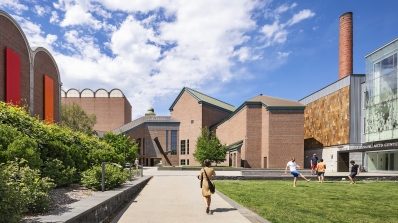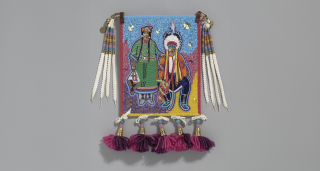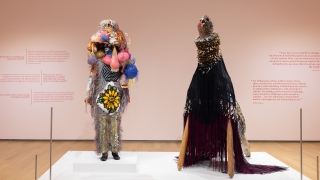Past Exhibitions
Weaving Ké explores the Diné (Navajo) concept of "Ké," which embodies community, family, and kinship. Ké reflects the generations of stories and emotions metaphorically woven into each object in this exhibition, emphasizing the deep connections to identity that this art represents. No matter the medium, these artists both express themselves and weave together narratives of self and community through their practice. Together, these objects invite us to reflect on the enduring significance of family and kinship within Indigenous cultures and emphasize art's vital role in connection and resilience.
A Space for Dialogue is a student-curated exhibition program that began in 2001. Hood Museum of Art interns create an installation drawn from the museum's permanent collection by engaging with every aspect of curation, from doing research and selecting objects, to choosing frames and a wall color, to planning a layout and writing labels and a brochure, to giving a public talk. There have been over 100 A Space for Dialogue exhibitions on a wide variety of themes.
Presence and Power in Europe, 1400–1750
Living with SculptureSculptures surround us in our daily lives. Similarly, they enlivened private and public spaces in medieval and Renaissance Europe, contributing to presentations of identity, practices of devotion, and promotions of nationhood. Featuring objects made across the continent, this exhibition examines the significance of sculpture between 1400 and 1750, an era of profound cultural and social change. Amid war, colonization, religious conflict, academic upheaval, and social stratification, these works of art ornamented homes, altars, libraries, and collections.
Organized thematically, this exhibition focuses on small-scale sculptures found in everyday spaces. New ways of making and designing sculpture enabled artists to enhance their status and develop their creativity. Meanwhile, useful sculptures like locks and inkwells communicated owners’ identities and prestige. Through practices of collecting and display, patrons harnessed sculpture to present their social connections and power. Sculpture also facilitated access to the divine, through objects that focused prayer and encouraged tactile connection with God. Similarly, sculptures forged a sense of history, recording contemporary events and promoting ideas about the past. Together, the sculptures presented here attest to how objects in bronze, wood, or stone gave meaning to people’s lives in early modern Europe.
Ghanaian photographer Gerald Annan-Forson portrays both political transformation and daily life in the African city during the last decades of the 20th century. This exhibition is only the second time his work has been shown in North America. His photographs tell the visual story of Ghana after it won independence from British imperial rule on March 6, 1957. Annan-Forson documents the changing landscape of Accra, the nation's capital, with its subtle moods and evolving cosmopolitanisms. His compositional style, playful focus, and formal repetitions challenge photographic conventions and disrupt viewer expectations by centering quirky figures and offbeat moments. His commitment to both spectacular occasions and the quiet intimacies of Ghanaian life places his images in dialogue with the previous generation of independence-era African photographers such as Felicia Abban, James Barnor, and Malick Sidibé and anticipates the recent explosion of photographers across the continent who are experimenting with documentary storytelling.
Meditations on Water
A Fragile ForceA Fragile Force: Meditations on Water pairs two video artworks, Electric Sheep by Amy Globus and Jennifer Moller's Seas. These two videos present meditative explorations of water, one focusing on icy waters meeting the shore, the other following an intelligent life form from its depths working through a man-made waterscape.
Indigenous Solidarity Throughout Pasifika and Beyond
Across OceansAcross Oceans: Indigenous Solidarity Throughout Pasifika and Beyond provides a glimpse into a diversity of contemporary Indigenous art based largely in cultures connected to the Pacific Ocean. These works, whose origins range from Australia to Hawaiʻi to the west coast of the United States and Canada, are brought together to reveal possibilities for solidarity and empowerment rooted in community, continuity, and self-determination.
A Space for Dialogue is a student-curated exhibition program that began in 2001. Hood Museum of Art interns create an installation drawn from the museum's permanent collection by engaging with every aspect of curation, from doing research and selecting objects, to choosing frames and a wall color, to planning a layout and writing labels and a brochure, to giving a public talk. There have been over 100 A Space for Dialogue exhibitions on a wide variety of themes.






